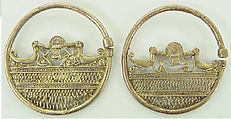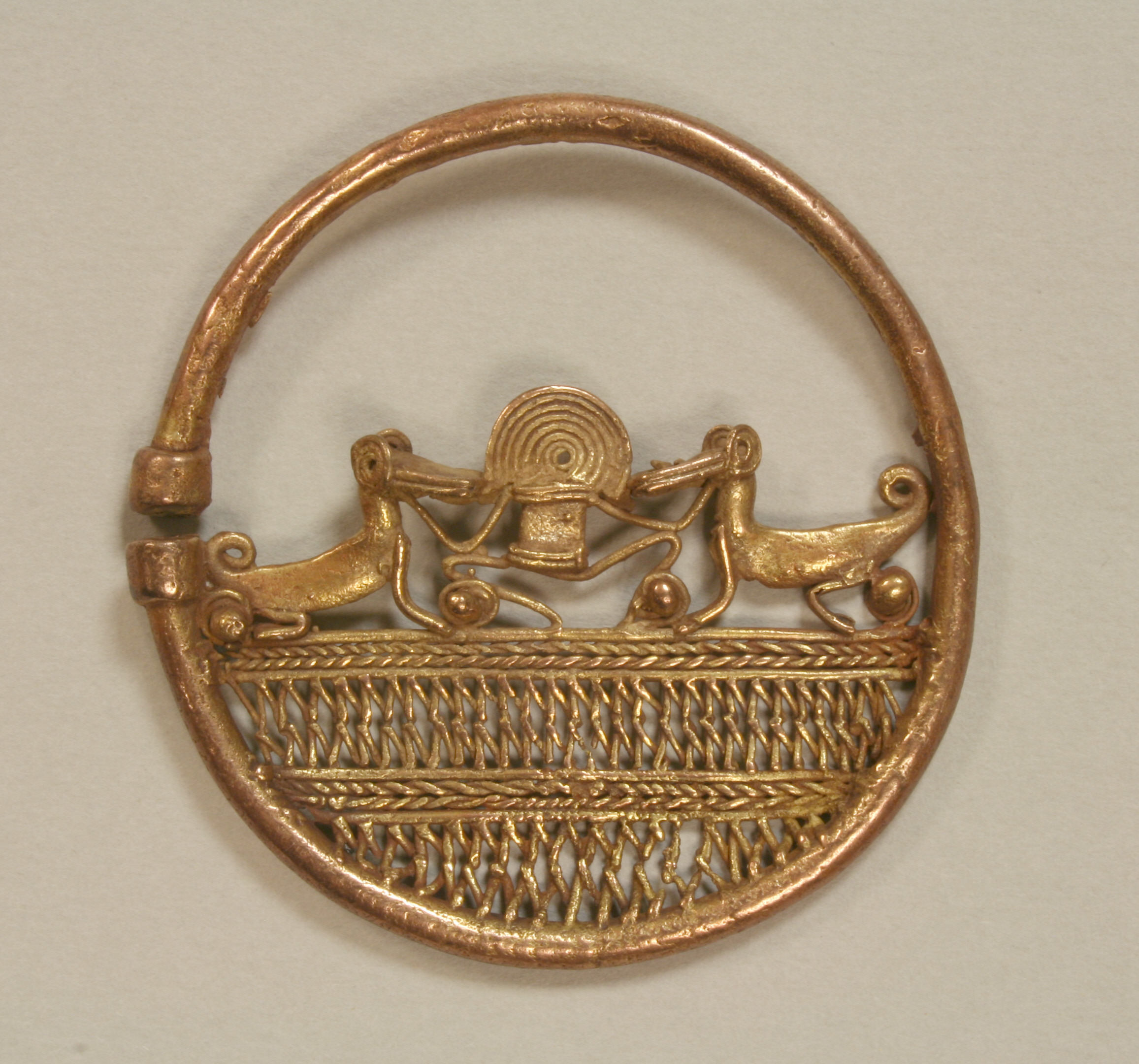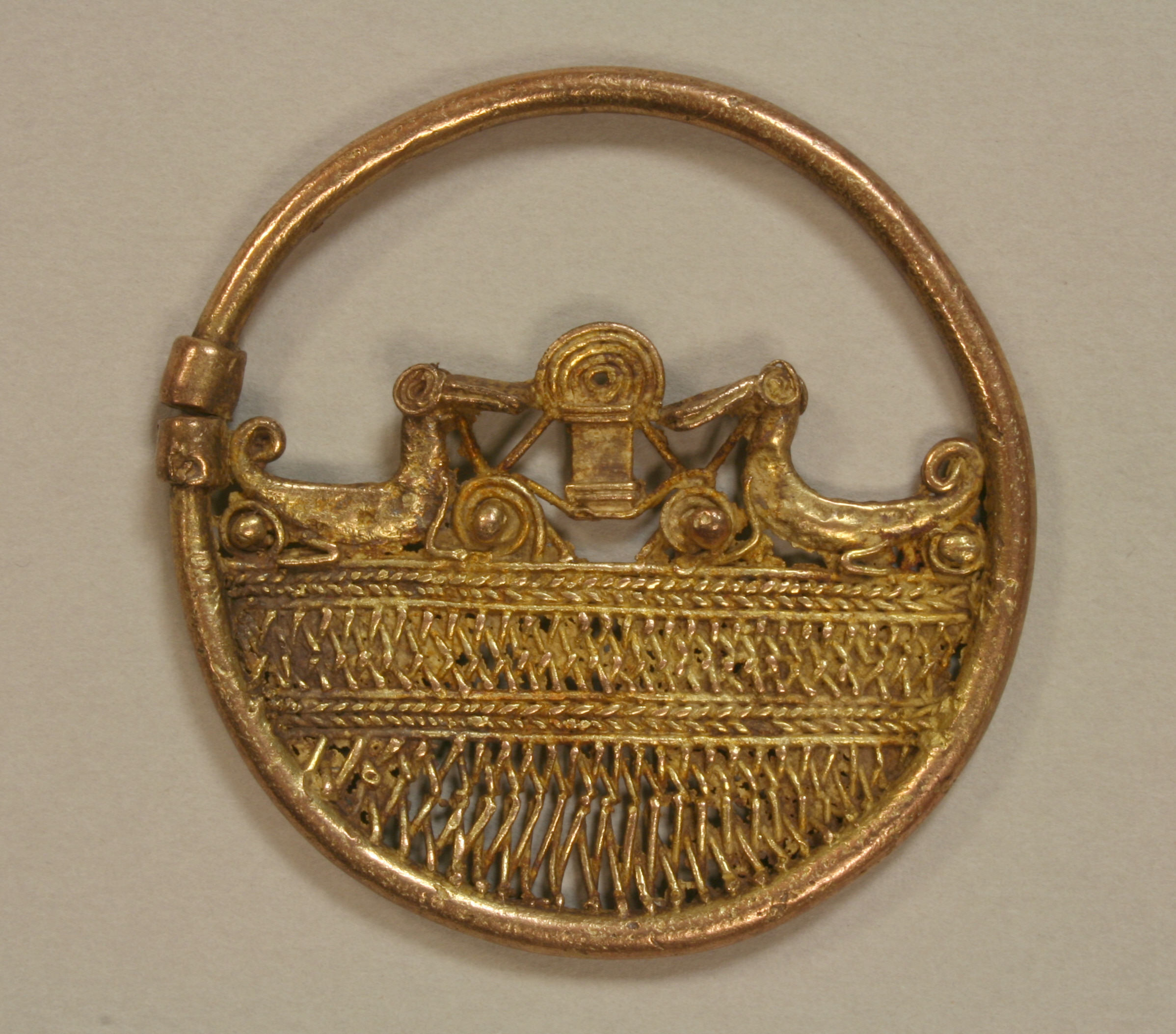Pair of Ear Ornaments
Not on view
Each of these two ear ornaments consists of a metal loop that encompasses a decorative scene. Though these two ornaments at first appear nearly identical, there are subtle differences that reflect the likelihood that they were cast using different wax models within the lost-wax casting process.[1] (For more information on this process, please see Metropolitan Museum of Art 2008.569.13a, b.) The two ornaments are part of the metalwork of Zenú people who lived and live today in the Caribbean Lowlands of Colombia. These are part of the group defined by Ana María Falchetti (1995, 58) as "cast filigree ear ornaments" or "orejeras de filigrana fundida," in which metal was cast to give it the appearance of wirework, or filigree. In recent centuries, people in Mompox, in the Zenú region, have been practicing filigree, using wire rather than casting metal. Today, they work typically in silver, and people’s memories point to early Zenú and Spanish Colonial-period metalworking traditions as origins of their practice (Lobo 2014).
In the case of each ornament in the present example, the circular loop is discontinuous to allow attachment to the ear. The loop has two capped ends, approximately 2 mm thicker than the loop is. The top capped end, which moves more freely, likely would have been inserted to a person’s ear when they wore the object as an ornament. The gap between these two ends is especially narrow on B, which may be a result of the fabrication or of a later stage of the object’s itinerary.
These two objects are likely a pair, and this is suggested by the internal decorative scene. The general form of this ornament—of a loop enclosing a scene—is common in Zenú metalwork (please see below), but the variation between these two objects is much smaller than that between the two together and other "pairs" of this form. How would a person have worn these ornaments? If they wanted to show what I am identifying as the "obverse," which is slightly different from the reverse face, they would have needed to push the cap through the left ear, approaching from the back, and through the right ear, approaching from the front. This is because the capped ends are on the same side on each ornament. However, this point assumes that the wearer wanted to display the same ornament face on each ear. Given the weight of the metal concentrated in the middle to lower half of each ornament, the scene likely would have been oriented as they are in the photographs when the ornaments were worn.
In each case, the internal scene involves two animals—perhaps mammals but also resembling birds—in profile that face each other. They each have a long snout that is relatively flat, spiral eyes, a tail that curls, and legs bent, appearing in a crouching position. Their heads are turned slightly, with their snouts pointing outwards from the ornament on the obverse; the heads appear in profile on the reverse.[2]
In between the two animals, there is a highly abstract anthropomorphic figure. Its head consists of a semicircular spiral, and its torso is a plain rectangular element with two horizontal bars at the top and bottom. This figure is crouching, with its elbows resting on its knees. The arms stretch outward and are connected to the underside of the snouts of the two animals. On the obverse, four spherical elements protrude from the surface, attached to the front a circular spiral in each instance, at the front feet and at the back of the animals. On the reverse, only the spirals are visible; the absence of the spherical elements here distinguishes the two faces.
Beneath the figural scene, the openwork design is entirely geometric. The design consists of two alternating registers. The artists made the first register by plaiting four wax threads to form a chevron design and added a plain horizontal band above and below the chevrons.[3] On ornament A, the chevrons point to the right on both faces, and on ornament B, they point to the left on both faces.
The chevron design alternates with a more open cast-filigree motif made by looping a small thread of wax and then twisting it.[4] The artists made tens of these looped-and-twisted threads to form a top row and a bottom row to each register, placing them in profile, and likely using a small amount of heat or pressure to delicately connect the individual threads and the larger rows. On the reverse of each ornament, the metal has spread slightly at these connecting points where heat or pressure was applied in the formation of the wax model. This loop-and-twist design is seen on other examples of Zenú ear ornaments (e.g., Metropolitan Museum of Art 1974.271.58 and 1974.271.59), but in the present examples, the design has more dimensionality.
Though the objects are a pair, the artists involved in making them prepared separate wax models. This difference is particularly evident in the size of the spirals at the front feet of the mammal figures—the spirals on ornament B are much larger—and in the size of the metal wire-like threads in the bottom register of the geometric design—again, the bottom row of ornament B is noticeably larger than those that appear on ornament A.
In addition, though both are likely made of gold or a gold alloy, the surface color of the two ornaments is different. Ornament A appears to have a redder tonality while ornament B is more golden. This difference in color may be the result of the use of two distinct alloys in casting, but more likely it arose in different treatments applied to the two ornaments after excavation.
The surface of ornament A shows some porosity as a result of gas molecules trapped in the molten metal during solidification. There are also small extrusions of metal, especially around the figural scene, that were produced by irregularities at the interface of the model and mold. Soil from burial is encrusted in the interstices of the ornament.
On ornament B, there is metal that has filled in some of the spaces between the looped-and-twisted threads, especially in the upper register of this design. This feature is likely an unintentional result of an incomplete investment, as the investment is meant to prevent metal from filling in areas beyond the shape of the wax model.
The two ornaments most resemble Type 9j of Falchetti’s classification system, which includes ear ornaments that show a geometric design and a scene "formed by a man at the center and a mammal, possibly a jaguar, on either side" ("formada por un hombre en el centro y un mamífero de cada lado") (Falchetti 1995, 71, fig. 22c,d). The sex or gender of the central figure is uncertain in the present example, and the mammals appear in this case to be more canine than feline. As noted above, it is also possible that the fauna have avian features and that the artists sought to depict animals that do not directly correlate with a particular species. Legast (1980, 17, fig. 4) defines the scene from one example (Museo del Oro [Bogotá] O20292) as comprised simply of two mammals and a human. This example, also shown in Falchetti (1995, fig. 22c), is from the Palomino River region, on the borders of the departments of Magdalena and La Guajira, while another (Museo del Oro [Bogotá] O19963) is from Colosó, Sucre. The provenances of these two objects, on the northern end or to the north of the Momposina Depression, are expected for this type of object. It is a hallmark of the San Jacinto Group (see Falchetti 2000, 145-148), a tradition of metalwork that appears to have emerged between A.D. 1000 and A.D. 1500 and focused around the Serranía de San Jacinto, with participation of Zenú people as well as Malibú people who lived around the Magdalena River. Practitioners of this tradition appear to have preferred using a gold-copper alloy with copper content higher than that employed in earlier Zenú metalwork. In this tradition, metalworkers frequently depicted animals as well as animals and humans together.
Some Zenú people envision the universe as comprised of three different layers, the middle of which humans occupy, while above and below, there are particular spirits related to animals (Turbay and Jaramillo 1998). The possible mammalian identification of the animals on these ornaments, and their association with an abstract figure, suggests that the artists are representing the middle plane of the universe in this register, although an identification of the fauna as birds—potentially water birds—implies movement across the universe, as these fauna are associated with a variety of environments (Falchetti 2000, 138). Indeed, the artists may be presenting all three layers, with the upper layer in the open space between the figural scene and the loop and the bottom layer comprised of the geometric openwork design.
Open questions include who may have worn these ear ornaments, if the objects are gendered, and whether they were fabricated solely for burial with human bodies. Falchetti (1993, 278), drawing on Spanish colonial documents, suggests that Zenú metal specialists may have created objects during funerary events to be interred with people as the events took place. However, objects from the Serranía de San Jacinto have been found, for instance, in the Sinú River Basin, and Malibú people, who influenced the San Jacinto Group, took special interest in the color and smell of gold-copper metal objects, employing them in marriage events and as trade items (Falchetti 1993, 279; Falchetti 2000, 148). Thus, people may have used, exchanged, and appreciated these ear ornaments for a significant part of their itineraries as objects before they were buried.
The Zenú region shows some of the earliest evidence of human occupation in Colombia. The archaeological site San Jacinto 1, in the Serranía de San Jacinto, was occupied as early as ca. 4000 B.C., with evidence of people making pottery and harvesting wild grasses to obtain seeds (Oyuela-Cacedo 1996). Communities have also been documented in the lower San Jorge River Basin as early as the 9th century B.C. (Plazas et al. 1993, 10; Plazas et al. 1996, 64). Around the 8th century B.C., at the onset of a period of drought, people began constructing a canal system considering that this area was prone to flooding. The canals were separated by artificial earthen platforms on which people lived. The system allowed for better drainage of the land that flooded during rainy periods and also helped to channel water throughout the area (Berrío et al., 2001; Falchetti 1995, 18; Plazas and Falchetti 1981, 19). Settlements in these areas proliferated during the more humid years between 150 B.C. and A.D. 500 (Plazas et al. 1996, 76). At its greatest breadth, the hydraulic system covered 500,000 hectares in the Momposina Depression, where the Cauca, Magdalena, and San Jorge Rivers meet, and 150,000 hectares around the lower Sinú River (Falchetti 1996, 10).
In the San Jorge River Basin, people created pottery known as Modelled and Painted, featuring cream colored vessels with modeled and appliquéd designs and red-painted geometric motifs (Falchetti 2000, 135; Plazas et al. 1993, 202). The River Basin provided fertile soil for cultivation of maize, manioc, chili peppers, and squash, and people supplemented their diets with aquatic fauna, including turtles and fish (Berrío et al. 2001, 163). There were also plentiful riverine sources of gold, especially around the Cauca and Nechí Rivers, supporting distinctive goldworking traditions (Falchetti 1995, 18–19). Typically working in gold and gold-copper alloys, Zenú metalworkers fabricated a range of forms primarily by casting metal or hammering metal sheet. Occupations in the Momposina Depression were concentrated between A.D. 500 and A.D. 1000, but some of the earliest Zenú metalwork appears to have been created in the first centuries A.D. (Falchetti 2000, 136).
After the 10th century A.D., the scope of settlements in the Momposina Depression appears to have dramatically reduced (Plazas et al. 1996, 76). At this time, there likely was interaction between Zenú and Malibú peoples, the latter of whom lived around the Magdalena River and moved into the San Jorge River region (Falchetti 2000, 147-148). These interactions may have produced a tradition of metalworking related to earlier Zenú practices, but concentrated in the Serranía de San Jacinto: in this tradition, people worked mainly with copper and gold-copper alloys with lower gold content than seen in other Zenú metalwork (Falchetti 1995, 32; Falchetti 2000, 145-147). This tradition shows a relation to the Betancí Complex, in which people produced a corpus of ceramics that included pedestal vessels, distinctive but also related to the Modelled and Painted tradition (Falchetti 1996, 15, 30). Just before Spanish colonization, the population density of the Lower Magdalena River, part of the Zenú region, was likely between 17 and 34 people for each square kilometer (Langebaek 2010, table 2).
[1] Metalworkers can fabricate relatively identical objects by creating a reusable mold from which they produce wax models. This is the indirect lost-wax casting process. The alternative, the direct lost-wax casting process, is that they create a wax model without a mold, making it more likely that the wax models, and the cast metal objects, will be different from one another.
[2] For the purposes of this description, the obverse is the side where the loop opening is on the left of the animal figures.
[3] Ellen Howe and Caitlin Mahony, Objects Conservation, generously explained the formation of this braided design.
[4] The narrow loop is especially visible on the bottom register of ornament B.
Related objects: 1974.271.58, 1974.271.59, 2008.519.13a, b
Further reading
Berrío, Juan Carlos, Arnoud Boom, Pedro José Botero, Luisa Fernanda Herrera, Henry Hooghiemstra, Freddy Romero, and Gustavo Sarmiento. "Multi-disciplinary Evidence of the Holocene History of a Cultivated Floodplain Area in the Wetlands of Northern Colombia." Vegetation History and Archaeobotany 10, no. 3 (2001): 161–74.
Cabildo Mayor Regional. Resolución N° 007. Córdoba – Sucre: Resguardo Indígena Zenú de San Andrés de Sotavento, 2010.
Chaves, Margarita and Marta Zambrano. "From Blanqueamiento to Reindigenización: Paradoxes of Mestizaje and Multiculturalism in Contemporary Colombia." European Review of Latin American and Caribbean Studies 80 (2006): 5-23.
Drexler, Josef. "¡En los montes, sí; aquí, no!": Cosmología y medicina tradicional de los Zenúes (Costa caribe colombiana). Hombre y ambiente 69-70. Quito: Abya-Yala, 2002.
Falchetti, Ana María. El oro del Gran Zenú. Bogotá: Banco de la República, 1995.
———. "El territorio Gran Zenú, en las llanuras del Caribe colombiano: Arqueología y etnohistoria." Revista de Arqueología Americana 11 (1996): 7-41.
———. "The Gold of Greater Zenú: Prehispanic Metallurgy in the Caribbean Lowlands of Colombia." In Precolumbian Gold: Technology, Style and Iconography, edited by Colin McEwan. London: British Museum Press, 2000.
Langebaek, Carl Henrik. "¿Cuántos eran? ¿Dónde estaban? ¿Qué les pasó? Poblamiento indígena en la Colombia prehispánica y su transformación después de la Conquista." In Colombia: Preguntas y Respuestas sobre su Pasado y su Presente, edited by Diana Bonnett Vélez, Michael LaRosa, and Mauricio Nieto, 27-52. Bogotá: Universidad de los Andes, 2010.
Legast. Anne. La fauna en la orfebrería Sinú. Bogotá: Fundación de Investigaciones Arqueológicas Nacionales, Banco de la República, 1980.
Lobo, Jimena. "Changing Perspectives: The Archives of Memory and Material Culture." Archaeological Review from Cambridge 29, no. 2 (2014): 69-87.
Navarette P., María Cristina. San Basilio de Palenque: Memoria y tradición: Surgimiento y avatares de las gestas cimarronas en el Caribe colombiano. Cali: Universidad del Valle, 2008.
Oyuela-Cacedo, Augusto. "The Study of Collector Variability in the Transition to Sedentary Food Producers in Northern Colombia." Journal of World Prehistory 10, no. 1 (1996): 49–93.
Plazas, Clemencia, and Ana María Falchetti de Sáenz. Asentamientos prehispánicos en el Bajo Río San Jorge. Bogotá: Fundaciones de Investigaciones Arqueológicas Nacionales, Banco de la República, 1981.
Plazas, Clemencia, Ana María Falchetti, Juanita Sáenz Samper, and Sonia Archila. La sociedad hidráulica Zenú: Estudio arqueológico de 2.000 años de historia en las llanuras del Caribe colombiano. Bogotá: Banco de la República, 1993.
Plazas, Clemencia, Ana María Falchetti, Thomas van der Hammen, Pedro Botero. "Cambios ambientales y desarrollo cultural en el Bajo Río San Jorge." Boletín del Museo del Oro 20 (1996): 54–88.
Due to rights restrictions, this image cannot be enlarged, viewed at full screen, or downloaded.
This artwork is meant to be viewed from right to left. Scroll left to view more.




